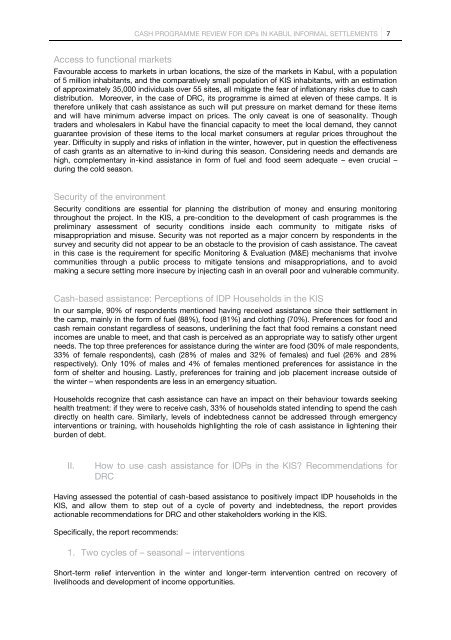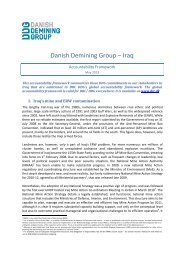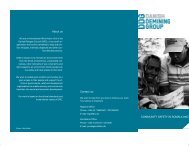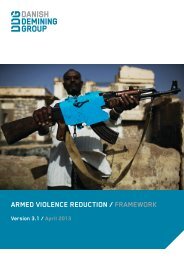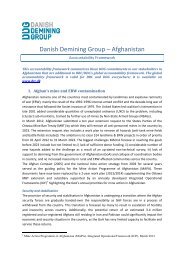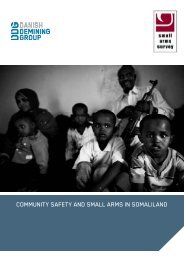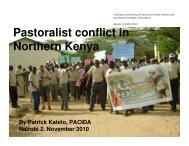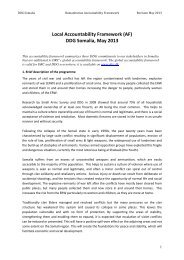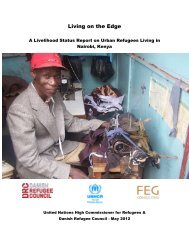Read the full report - Danish Refugee Council
Read the full report - Danish Refugee Council
Read the full report - Danish Refugee Council
Create successful ePaper yourself
Turn your PDF publications into a flip-book with our unique Google optimized e-Paper software.
CASH PROGRAMME REVIEW FOR IDPs IN KABUL INFORMAL SETTLEMENTS 7Access to functional marketsFavourable access to markets in urban locations, <strong>the</strong> size of <strong>the</strong> markets in Kabul, with a populationof 5 million inhabitants, and <strong>the</strong> comparatively small population of KIS inhabitants, with an estimationof approximately 35,000 individuals over 55 sites, all mitigate <strong>the</strong> fear of inflationary risks due to cashdistribution. Moreover, in <strong>the</strong> case of DRC, its programme is aimed at eleven of <strong>the</strong>se camps. It is<strong>the</strong>refore unlikely that cash assistance as such will put pressure on market demand for <strong>the</strong>se itemsand will have minimum adverse impact on prices. The only caveat is one of seasonality. Thoughtraders and wholesalers in Kabul have <strong>the</strong> financial capacity to meet <strong>the</strong> local demand, <strong>the</strong>y cannotguarantee provision of <strong>the</strong>se items to <strong>the</strong> local market consumers at regular prices throughout <strong>the</strong>year. Difficulty in supply and risks of inflation in <strong>the</strong> winter, however, put in question <strong>the</strong> effectivenessof cash grants as an alternative to in-kind during this season. Considering needs and demands arehigh, complementary in-kind assistance in form of fuel and food seem adequate – even crucial –during <strong>the</strong> cold season.Security of <strong>the</strong> environmentSecurity conditions are essential for planning <strong>the</strong> distribution of money and ensuring monitoringthroughout <strong>the</strong> project. In <strong>the</strong> KIS, a pre-condition to <strong>the</strong> development of cash programmes is <strong>the</strong>preliminary assessment of security conditions inside each community to mitigate risks ofmisappropriation and misuse. Security was not <strong>report</strong>ed as a major concern by respondents in <strong>the</strong>survey and security did not appear to be an obstacle to <strong>the</strong> provision of cash assistance. The caveatin this case is <strong>the</strong> requirement for specific Monitoring & Evaluation (M&E) mechanisms that involvecommunities through a public process to mitigate tensions and misappropriations, and to avoidmaking a secure setting more insecure by injecting cash in an overall poor and vulnerable community.Cash-based assistance: Perceptions of IDP Households in <strong>the</strong> KISIn our sample, 90% of respondents mentioned having received assistance since <strong>the</strong>ir settlement in<strong>the</strong> camp, mainly in <strong>the</strong> form of fuel (88%), food (81%) and clothing (70%). Preferences for food andcash remain constant regardless of seasons, underlining <strong>the</strong> fact that food remains a constant needincomes are unable to meet, and that cash is perceived as an appropriate way to satisfy o<strong>the</strong>r urgentneeds. The top three preferences for assistance during <strong>the</strong> winter are food (30% of male respondents,33% of female respondents), cash (28% of males and 32% of females) and fuel (26% and 28%respectively). Only 10% of males and 4% of females mentioned preferences for assistance in <strong>the</strong>form of shelter and housing. Lastly, preferences for training and job placement increase outside of<strong>the</strong> winter – when respondents are less in an emergency situation.Households recognize that cash assistance can have an impact on <strong>the</strong>ir behaviour towards seekinghealth treatment: if <strong>the</strong>y were to receive cash, 33% of households stated intending to spend <strong>the</strong> cashdirectly on health care. Similarly, levels of indebtedness cannot be addressed through emergencyinterventions or training, with households highlighting <strong>the</strong> role of cash assistance in lightening <strong>the</strong>irburden of debt.II.How to use cash assistance for IDPs in <strong>the</strong> KIS? Recommendations forDRCHaving assessed <strong>the</strong> potential of cash-based assistance to positively impact IDP households in <strong>the</strong>KIS, and allow <strong>the</strong>m to step out of a cycle of poverty and indebtedness, <strong>the</strong> <strong>report</strong> providesactionable recommendations for DRC and o<strong>the</strong>r stakeholders working in <strong>the</strong> KIS.Specifically, <strong>the</strong> <strong>report</strong> recommends:1. Two cycles of – seasonal – interventionsShort-term relief intervention in <strong>the</strong> winter and longer-term intervention centred on recovery oflivelihoods and development of income opportunities.


